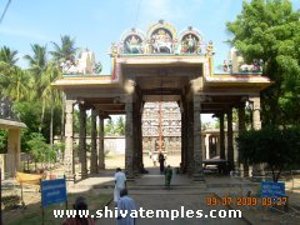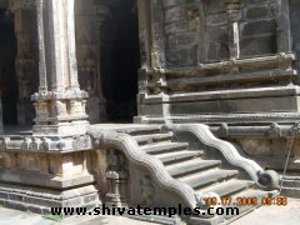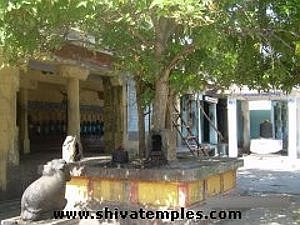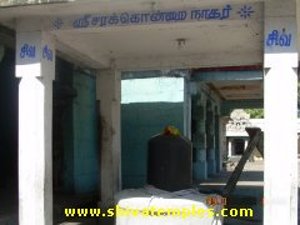Temple Legend - Thiruvathigai stands out as one of the eight sacred sites where the valorious power of Lord Shiva was vividly displayed. It was at Thiruvathigai that Lord Shiva executed the Tripura Samhara, a significant event that took place at Thiruvathigai and it is considered as one of the eight 'atta veerattana sthalam'. The narrative unfolds with the presence of three formidable demons - Vidyunmali, Tharukaksha, and Kamlaksha, who resided in three impregnable moving cities or forts collectively known as Tripura, constructed from gold, silver, and iron, respectively. These malevolent demons wreaked havoc across the universe, causing distress to the celestial beings known as Devas. Overwhelmed by the torment inflicted upon them, the Devas sought the intervention of Lord Shiva to rid them of this menace. In response to their plea, a celestial chariot was crafted, with the four Vedas as four horses, Lord Brahma assuming the role of the charioteer, the sun and moon serving as the right and left wheels, respectively, and various other worldly creatures adorning the chariot and forming the army. Each member of the divine army took pride in their contribution, believing that their efforts were pivotal in Lord Shiva's impending victory over the three demons. However, Lord Shiva, perceiving their growing sense of pride, sought to assert his supremacy by gently smiling, thereby quelling the arrogance among the Devas. This benevolent smile, radiating joy and brightness, had a profound impact - it brought about the well-being of those demons in Tripura who remained steadfast in their worship of Shiva, while simultaneously leading to the demise of those demons who wavered in their devotion. The moment Lord Shiva chuckled, the three formidable forts were reduced to mere dust, signifying the culmination of the divine intervention at Thiruvathigai. This sacred site serves as a poignant reminder of the events that transpired, underscoring the power and benevolence of Lord Shiva in vanquishing evil forces and restoring harmony in the universe through his divine grace.
See also - Other Paadal Petra Shivasthalam associated with Tripura Samhara - 1) Elambayankottur, 2) Tiruvirkolam., 3) Achirupakkam
Tirunavukkarasar - In the 7th century, a couple named Thiru Pukalanar and Mathiniyar had two children, a daughter named Thilakavathy and a son named Marulneekiar, in the village of Thiruvamur in Thirumunaipadi Nadu. During his childhood, Marulneekiar was attracted to Jainism and eventually joined a Jain monastery, taking on the name Dharmasena. Meanwhile, Thilagavathiar, after the death of her betrothed Kalipagayar, a military commander, chose to lead an ascetic life and devoted herself to Lord Shiva. Thilagavathiar was displeased by her brother's conversion to Jainism and prayed to Lord Shiva. At the same time, Marulneekiar suffered from severe stomach pain that could not be cured. Seeking help, he turned to his sister, who brought him to the Tiruvathigai temple and provided him with the temple's holy water and sacred ash (viputhi) as medicine. She encouraged him to pray to Lord Shiva with all his heart. It is believed that Marulneekiar was instantly cured and relieved of his pain after he swallowed the 'viputhi'. He spontaneously sang his first pathikam, beginning with the line “Kootru Aayinavaru”. Lord Shiva was pleased by his poetic skill, and it is believed that at this point the lord’s divine voice was heard saying that “Marulneekiyar will henceforth be known to the world as ‘Thirunavukkarasar’ (Thiru-Sri; Navu-Tongue; and Arasar-King) and that his glories will be etched in history forever”.
The innermost third prakaram houses the sanctum of the presiding deity Athikai Veerateshwar, represented as a 'Swayambhoo Lingam'. Positioned behind the 'Moolavar' are Shiva and Parvathy in their 'Tirumana Kolam'. The vimanam situated above the sanctum, which dates back to the Pallava dynasty, stands as a remarkable architectural feat. This structure is designed in a unique manner that renders its shadow completely invisible, adding to the mystique and grandeur of the temple complex. Garuda, Brahma, Vishnu, and the Pancha Pandavas have paid homage to the presiding deity of this temple. Their worship and presence further enrich the spiritual significance and historical importance of this revered place of worship.
The Panchamukha Lingam, located in the south-west corner of the inner prakaram, is an essential sight to behold, dating back to the Pallava period. This unique Lingam is unparalleled in Tamil Nadu, with its four faces directed towards the four cardinal directions, and the fifth face believed to be facing upwards, making it a rare and extraordinary sight. Adjacent to it are numerous Shivalingams arranged in a row, alongside the yagasalai and navagraha shrines, and the Nataraja Sabha.
Lord Muruga here is with His two beautiful consorts Valli and Deivanai. Saint-poet Arunagirinathar has sung 2 songs in praise of Muruga in his Thiruppugazh collection.
Sundarar, out of reverence for Tirunavukkarasar, chose not to walk on the areas where Tirunavukkarasar had performed 'Uzhavara pani' (volunteer work in maintaining the temple premises). Instead, he stayed at the nearby Siddhavada mutt and continued his worship of Athikai Veeratteshwarar. While sleeping at night, Sundarar felt someone pushing him with their foot, and then felt a blow to his head. Upon waking up, he scolded the person who had touched his head, only to realize it was Lord Shiva himself. A Pallava king Mahendravarman-I, was converted from Jainism to Shaivism under the influence of Tirunavukkarasar. It is believed that Mahendravarman-I destroyed a Jain monastery and built a temple called Gunavareswaram near the temple, leading to him being known as Gunavareswara. These two incidents involving Sundarar receiving 'Tiruvadi Deekshai' and Mahanderavaran highlight the significance of this temple.
 16 pillar mandapam in front of Rajagopuram
16 pillar mandapam in front of Rajagopuram 16 pillar mandapam in front of second gopuram
16 pillar mandapam in front of second gopuram Second gopuram
Second gopuram Dwajasthambam, Balipeetam, Nandi
Dwajasthambam, Balipeetam, Nandi Nandi
Nandi Way to Moolavar Sannidhi
Way to Moolavar Sannidhi Dwajasthambam, Balipeetam and Nandi before
Dwajasthambam, Balipeetam and Nandi before Outer prakaram
Outer prakaram Sthala Vruksham - SaraKondrai
Sthala Vruksham - SaraKondrai Sarakondrai Nathar sannidhi
Sarakondrai Nathar sannidhi